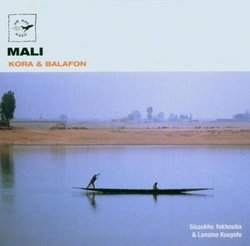Somewhere in Mali...
Giordano Bruno | Wherever I am, I am. | 10/05/2008
(5 out of 5 stars)
"... I hope these two artists are still making music, the same music without acoustic bass or programmed chords on electric piano, but chances are they're both driving taxis in New York or Paris. This is as authentic a recording of the traditional pre-globalization music of Mali and West Africa in general as you'll be able to find, other than scratchy ethnographic tapes made 50 years ago. It's not music that requires any apologies; it's vibrant, graceful, and skillfully played on two ancient Malian instruments.
The "kora" is the harp of West Africa, built from a huge gourd, with about 21 strings. It's the instrument used by "griots" to accompany themselves as they sing or recite genealogical histories. The "balafon" is a basic xylophone with gourd resonators. The built-in scales of the two instruments constrain and shape the muisc they can produce, but beyond that fact, skilled players can be as virtuosic on such hand-made acoustic instruments as on a modern pedal harp or an electrified marimba. That's what you'll hear on this CD, two virtuosos of their tradition jamming together and firing each other up to transcend their instruments. The recording quality, by the way, is excellent, making these rather quiet instruments fill the soundscape.
Just as an aside, let me pose a question. It's declared often and loudly that the roots of American jazz are in a heritage of West African music brought to this New World by slaves. I suppose that's an attempt to give "credit" to African-Americans for musical vitality, but the credit isn't credible, and doesn't assign nearly enough credit to those jazz pioneers. How much like jazz does this music sound? Do you hear "blue" notes? Do you hear jazz syncopation? Uh uh. The instruments of early jazz were the instruments of Europe - trumpet, trombone, clarinet, mandolin - not the kora or the balafon, not even the typical hand drums of Africa. The musical forms of early jazz were stylistic departures from European marches and dance music. The genius of African-American descendants of slaves was to reshape European music to their own cultural sensibilities to to create something so vital that it flowed back across the Atlantic to both Europe and Africa, influencing the 20th C music of 'classical' composers and of 'high-life' orchestras in the new cities of West Africa.
But aside from my aside, let me recommend this CD as one of the most enjoyable examples of traditional African music I've encountered."


 Track Listings (5) - Disc #1
Track Listings (5) - Disc #1